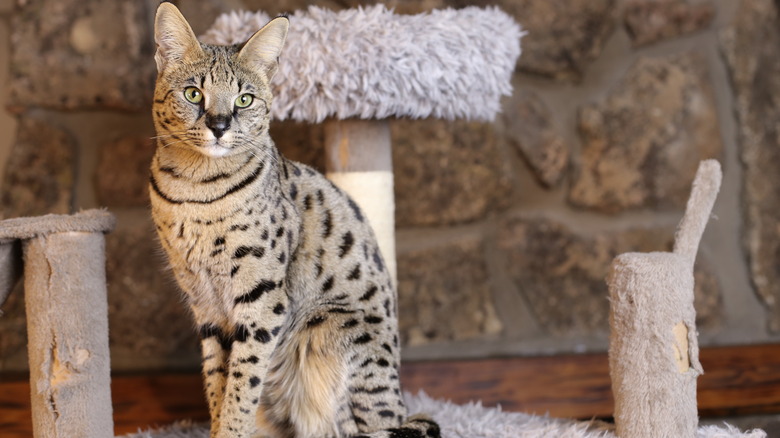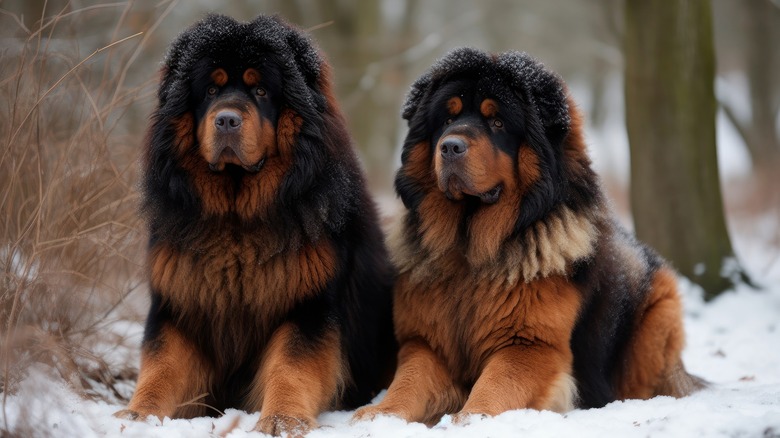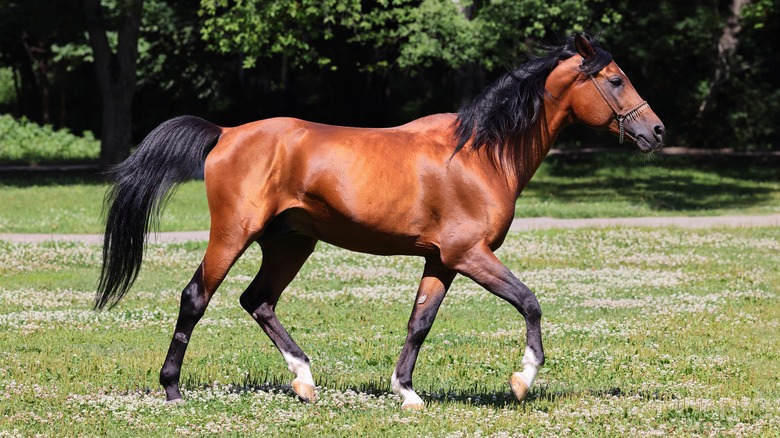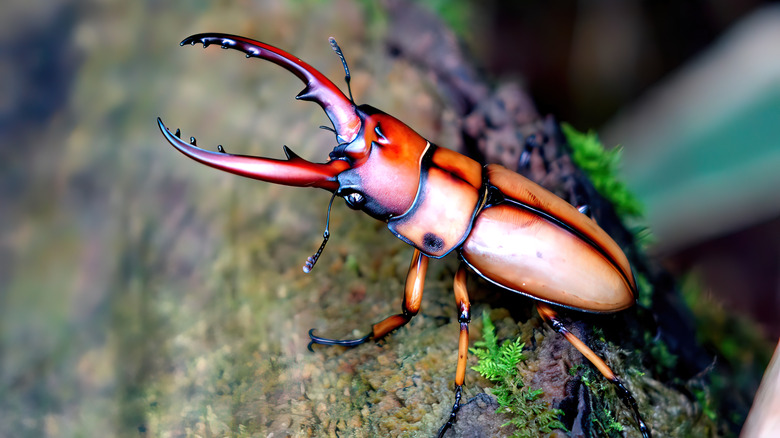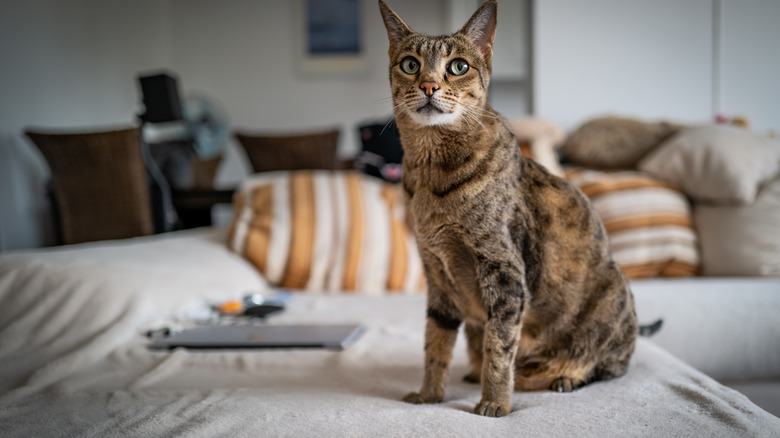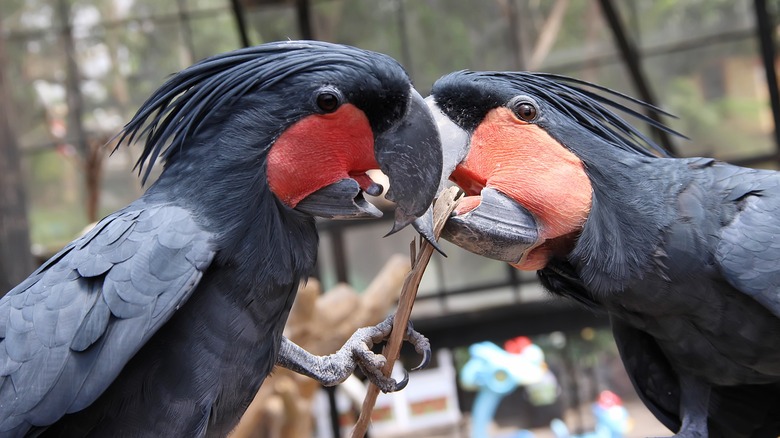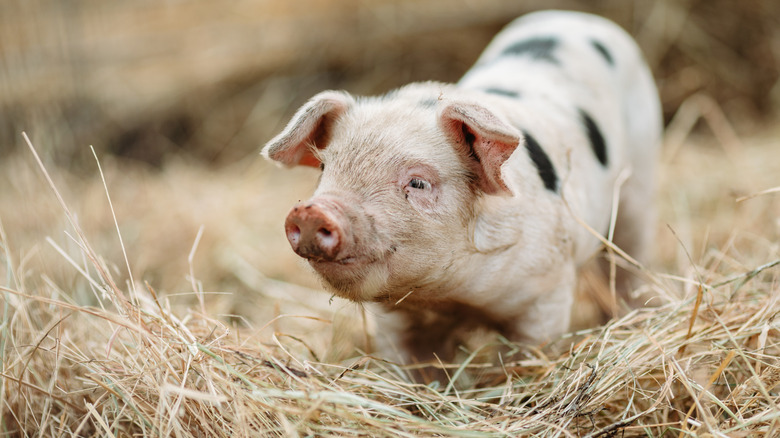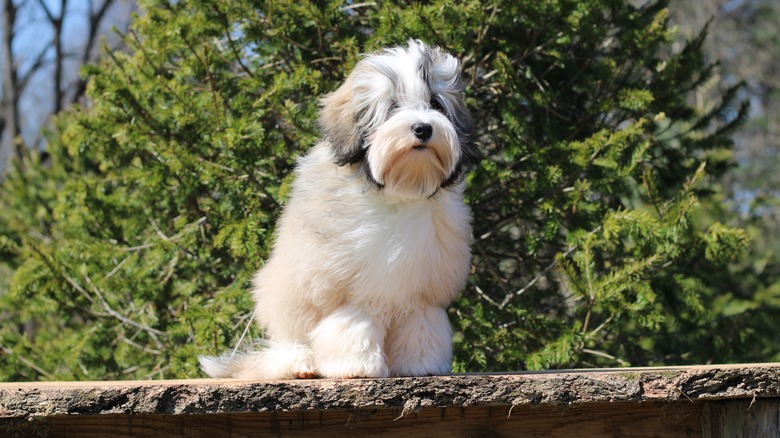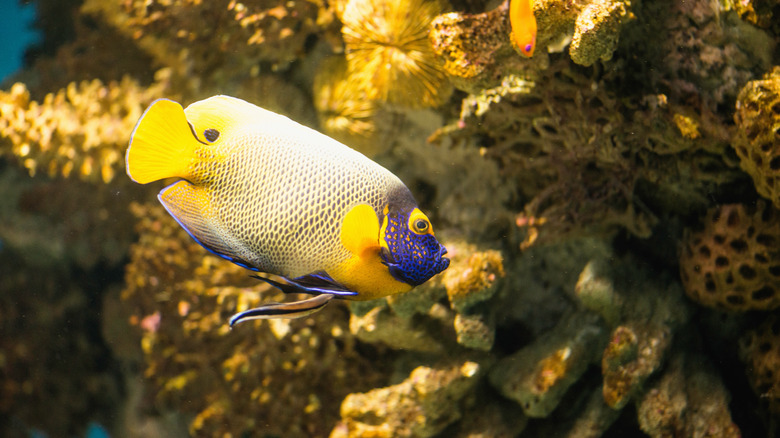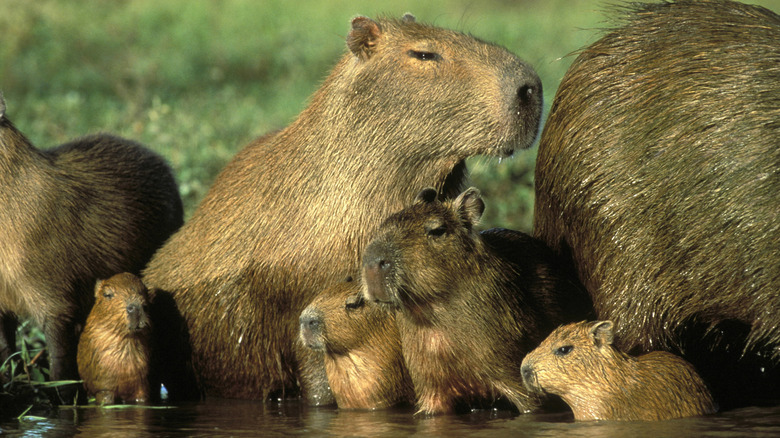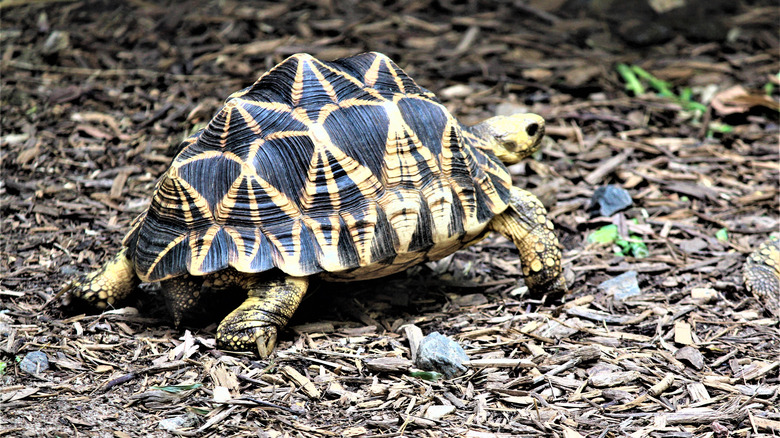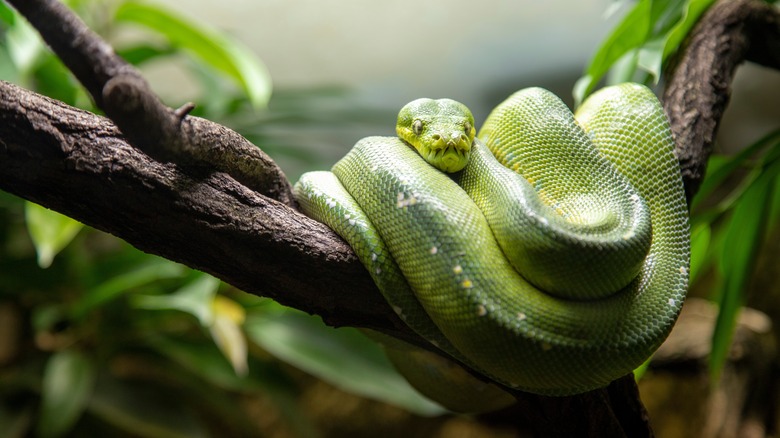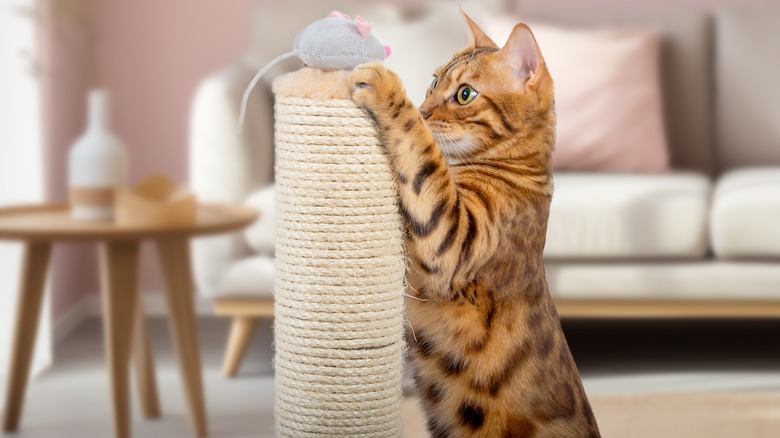The Most Expensive Types Of Pets You Can Buy
Pet parents certainly know how costly our furry, feathered, or scaled friends can be. It's estimated that the average American spends roughly $770 on their pets per year. Affordability is always a consideration when you take a new companion into your home; but for many it's is an expected part of ownership taken out of love. Per MetLife, people spend anywhere from $50 to as high as $1,000 to adopt a dog, while the Cat Humane Society reports people typically spend in the hundreds to bring a feline friend into their family.
Yet what if money were not an issue, and you could indulge in purchasing any pet? Or perhaps you have finally saved enough to realize your dream of welcoming a more uncommon companion into your house. Certain pets will certainly cost you a lot more than adopting a dog or cat. These are some of the most expensive pets you can buy, whether by base purchase price or for rarities within pets that see them sold at a high value. We will also review the legality of many of these entries, as rarity often equals expense and potential restrictions; you can also check yourself via findlaw.com list of exotic animal bans.
Tibetan Mastiff
This Mastiff is a large working dog originally from the Himalayas with a long history as a protector and companion to the Tibetan people. The breed is a loyal companion that can be both a protector due to its size (averaging between 140-170 pounds) and an entertainer due to its stubborn and aloof nature. Mastiffs are a rare breed in North America, which already makes their price range for pups on the higher end, ranging from two to six thousand.
While some mastiff breeds face restrictions in the USA, the Tibetan mastiff faces few in comparison. If you can find a breeder in the United States. They are a relatively healthy breed, but their size and constant shedding can be expensive when considering accommodating them into your home.
While there are more expensive dog breeds to purchase, the hearty pooch is notable for its status in its native home China. As reported in the New York Times, these dogs have been sold at record prices, the highest going for $1.9 million in 2014. The huge price tag is due to the implied "lion's blood" that comes with a 100% purebred Tibetan Mastiff. However, the Tibetan mastiff has also become a boast by their owners, inflating their prices; you are better off getting a pup here in America from a reputable breeder.
Arabian horse
It is difficult to understate how key the Arabian horse was in the development modern society. Believed to have dated back as far as 2500 B.C., the Arabian horse was a prized item among many cultures and considered a cherished spoil of war. It is no hesitation to say that some of the most significant historical events predating industrialization included the prized breed, such as Marengo, the favored mount of Napoleon Bonaparte.
The horse's prominence throughout history has made it a deeply admired breed, so its transition to becoming beloved pet is not surprising. The Arabian is highly intelligent and durable, making it perfect for long treks with a companion who is willing to put in the training. While Arabian horses have a reputation for being hot-blooded, many owners rebuke this claim. Seasoned rider Sanne Westeram, who has had the chance to ride Arabians in many different countries, speaks to their adaptability and easy approachability for trail riding.
The upkeep and housing of any horse already makes them expensive pets to own, and instead of purchasing one, you may want to look at co-op or boarding, bearing in mind that an Arabian horse can live between 25 and 30 years. To purchase an Arabian, you can expect to pay between $5,000 to $30,000. For reference, that's more than three times the average price for most pet horses in the U.S, which runs between $500 and $3,000. The most expensive Arabian ever sold at the market was a stud named Pepita, going for 1.4 Million euros in 2014 (over $1.5 million U.S. dollars).
Stag beetle
Certainly, a stag beetle, a bug one can find in certain habitats naturally, can't be that expensive, can it? When it comes to bugs as pets, there is a bit of nuance here, particularly when considering the region. Bug collecting remains a niche hobby in North America, but the industry thrives in other countries. This includes Japan, where it is not uncommon for children to take up bug collecting.
For starting collectors in the USA, most species of stag beetles cost between $15 and $50 dollars, though some can fetch higher prices in the hundreds. This price is low considering its rarity, with the U.S.A. homing the Giant Stag Beetle as the most prominent species, but these numbers are not substantial. Beyond conservation efforts, entomology enthusiasts will collect stag beetles for their unique appearance and behavioral interests, including observing the breeding process.
Avid collectors may be looking to pay more as they search for the largest and most unique specimens. The highest on-record sale was a staggering (pun intended) $89,000. Other factors affecting price include rarity and supply, which can also lead to inflated prices for a specific beetle. The ins and outs of owning beetles can be daunting, as you need to be aware of any state restrictions. If interested, you should find enthusiast groups online to ensure you follow the right steps to give these mighty beetles a proper home.
Savannah cat
A hybrid between a wild African serval and the domestic house cat, the Savannah has risen in popularity in recent years, which has come with its controversies. Interest has led to some unwanted breeding practices and many owners being in over their heads with homing the very active cat breed, overwhelming potential owners who want that Instagrammable cat (they are profoundly beautiful felines) but don't understand the commitment needed. Savannahs can vary drastically depending on their 'type,' categorized by 'filial generation' and other factors, per Savy Paws.
Their type also indicates their price, with the most expensive coming from the 'F1' category, a distinction that indicates its genetically closest to its serval roots. The 'F1' can range between $10,000 and $18,000 in price compared to the later generations further removed from their African ancestors. The more domesticated savannah, 'F5 and above,' will cost its pet parent between $1,000 and $2,000, yet as far as which makes the best pet, the later generations are both more affordable and have a similar temperament to the more familiar domestic feline.
Pet parents who wants to own an exotic cat like this may run into legal problems depending on their state. Six states have banned the ownership of any 'wild animals' (including exotic cats), and seven don't allow for ownership of any feline above the 'F4' classification. Savannah Cats Association has details on which states restrict the savannah to pets.
Black Palm cockatoo
Those who have never been pet parents to a feathered friend may underestimate the abundance of compassion and entertainment they can bring. Cockatoos can make great pets for those who stay home and can dedicate essential time to the overly affectionate bird. The black palm cockatoo is no different in its constant need for attention, though this bird has become distinguished among the cockatoos for its looks; owners often covet it as one of the most beautiful breeds.
Native to New Guinea and Queensland, Australia, this hefty price is because the black palm is currently listed as endangered due to its shrinking native habitat and low breeding rates. This means a black palm cockatoo must be purchased through USDA-licensed breeders and that there may also be state-specific restrictions you must abide by. It is always best to research before considering homing a black palm or any exotic bird.
The breed's rarity, with limited sellers in the U.S., can make it challenging to find one of these prized birds for purchase. Searching online sellers shows that availability comes and goes, and prices can range between eight and sixteen thousand; some go even higher. It is also important to note that parrots have very long life spans, with the black palm living between forty and ninety years. The cockatoo is a pet that needs an experienced and committed owner. There is a history of cockatoos and other exotic, long-living birds being abandoned or homeless (don't be that person).
Mini pigs
With their affectionate personalities and adorable looks (how can you not love those little tails), mini pigs have become a highly desired among pet parents. Their intelligence makes them comparable to cats and dogs, as you can house-train them, take them on walks, and teach them basic tricks. Still, with the popularity of these squealing cuties, there have been issues, including pigs not being matched with suitable homes. The rescue Home for Hooves reported that nine out of ten pot-belly pigs end up surrendered by their owners because they are unaware of the responsibility of owning a pig. Many pet parents have bought 'mini-pigs' only to find them grow upward of two hundred pounds.
If you want a piglet from a breeder, the prices can range from $1,200 to $6,000 depending on age, size, and whether they are registered. With so many pigs surrendered, you can get a pet mini pig through resources such as the Pig Placement Network. However, regardless of where your pig comes from, ongoing costs can also vary drastically depending on how big your piggy gets. Each animal can eat six pounds per day of varied food and requires roughly fifty square feet of space to roam. If you want to purchase a porcine companion, you must be aware of any state or municipal restrictions regarding farm animals. Also, be wary of people selling 'teacup pigs.' A teacup pig is just a regular pot-belly pig.
Löwchen
The Lowchen may very well be one of the most adorable little dog breeds you will come across; their name means little lion from their native Germany. They may be a little borky, like many other smaller breeds, but they are overly affectionate dogs that fit in well with just about any family due to their kind and loving nature. Sadly, the popular European small breed had a tough go, and its numbers dwindled during the two World Wars. Its preservation owed almost entirely to one remarkable woman named Madame Bennert.
Lowchens are the ideal pet for those looking for small and charismatic companions, and their kind nature and adorable size come with the benefit that you don't have to worry about restrictions on owning this mini-lion. The higher price comes from the Lowchen being considered rare, even though its numbers have steadily increased yearly. The breed's scarcity is reflected in the price of puppies, which average between four and eight thousand. Thankfully, this is a healthy breed with a thirteen to fifteen-year lifespan, so they are generally more affordable after that steep adoption price.
Masked Angelfish
Those who own an aquarium and enjoy collecting exotic fish know how much prices can fluctuate depending on size, rarity, and appearance. The most expensive fish you can add to your tank is the Asian arowana, which can fetch upwards of $300,000. However, because the arowana is illegal to own in the U.S.A, we will focus on another coveted fish, the masked angelfish.
The masked angelfish is a protected species in its native Hawaii, and very few have been collected over the past several decades. Its rarity and beauty have made it highly valued by collectors, with one buyer in 2009 paying $30,000 for a pair of the fish. Online availability is scarce and dependent on stock, but one site has a single masked angelfish currently listed for just under $16,000.
A masked angelfish could certainly make a show stopping addition to any aquarium. When properly introduced, the prized angelfish can live harmoniously with other fish. That said, these fish still require plenty of space to swim, and its recommended they live in a space that is no smaller than a 150-gallon tank. Though there are no specific restrictions on owning a masked angelfish, it is important to check state and city laws concerning the owning and transporting of rare species.
Capybara
The capybara has the title of the largest rodent in the world, weighing between 60 to 174 pounds, and measuring between 3.2 to 4.2 feet long. Capybaras can be shy and struggle to connect with their owners; they require patience and understanding from anyone who wishes to adopt them. Still, they are naturally affectionate creatures that love to talk and vocalize through grunts, purrs, and various other sounds. A caretaker may attempt to talk back to help their pet feel welcome, but it is recommended that capybaras are bought in pairs to ensure their social requirements are met.
Purchasing prices range depending on location, but, generally, you can expect roughly $2,500 for one, though females can fetch a slightly higher price. Before even considering adoption, you need to be aware of restrictions, as only thirteen states allow the capybara as a pet. There may be further restrictions based on the municipality. These are not starter rodents; you may want to begin with the under appreciated yet adorable rat before trying to home one of these impressively sized creatures.
The giant rodents also need plenty of outdoor space, as you cannot litter-train these big pets. One-to-three capybaras will require a fenced-in area of approximately 240 square feet, access to a water hole at least 3.5 feet deep. You must also be prepared for food costs, as an adult male capybara can eat up to 6 to 8 pounds daily.
Burmese star tortoise
The Burmese star tortoise has become prized for its beautifully patterned and unique shell shape; some compare its lush colors and layout to a floral arrangement. To keep as pets, these turtles need a fair amount of open space, growing between ten and thirteen inches. These tortoises are native to Myanmar and require proper environmental care and indoor accommodations.
Any potential pet parent should also note that the Burmese star tortoise is considered endangered and has never been traded legally outside of its native country. Their status plays into the morality of owning this beautifully patterned turtle, as sales from breeders will have their roots in illegal trade. At the same time, the future of the animal in the wild is now uncertain, meaning that captive and conserved species may be the only chance this species has to survive.
The cost to purchase a Burmese star tortoise ranges between $1,000 to $5,000. Subsequent costs can add up fast, with the need for a remodeled outdoor space that provides a turtle run and access to water. Depending on the climate, tortoise parents made need to invest in an indoor space, too. Putting aside the morality of owning an endangered species, you may face state and federal restrictions, as well as fees with owning a Burmese star tortoise outside of conservation; Maine, for example, requires owners of certain exotic reptiles to have a permit. Any out-of-country purchases of the Burmese star tortoise are highly illegal.
Green tree python
Tracking the sale of the coveted green tree python can be difficult, with some unverified reports mentioning that it has sold for as high as $445,80, marking it the most expensive snake in the world. However, there is some nuance when collecting pet snakes, as some can be more prized for their appearance (morph rarity), and two slithery pets of the same type can go for drastically different prices. The reported high-end sale is possible, considering it could have been a rare morph, but the green tree python still fetches a hefty price, ranging from $400 to just under $1,000.
Caring for these giant reptiles incurs additional expenses. You are looking at over one thousand dollars for a proper home with all the bells and whistles to keep your scaly friend content, coming with a potential hike in your electricity bill to keep their lights on. On top of that, feeding a green tree python will cost around $50 to $100 a month. And, considering they live up to 20 years, those costs become a long-term commitment.
Native to New Guinea, Indonesia, and Australia, the green tree python has been subject to species protection and trade restrictions. Still, thanks to local breeders, the legality of owning a green tree python depends solely on any state and municipal restrictions. Snakes can be adorable to the proper pet parent, but careful consideration is required before bringing such a large species into a home.
Bengal cat
Like the Savanah, the Bengal is a crossbreed of domestic cats, and a wild breed, the Asian leopard cat. Bengals are considered extremely rare because they have a highly restricted breeding standard. For this reason, if you're purchasing a Bengal from a reputable breeder, expect to pay between $1,500 and $3,000 for a kitten. However, depending on the specific type (such as one variation that is mixed instead with the Amur leopard cat), prices can go as high as $10,000 or more.
For a third-generation Bengal, you can expect to pay around $2,000 which comes from the costs incurred by a reputable breeder. According to The Bengal Connection, most breeders will barely profit from adoptions. The cat breed is generally healthy, but they are also prone to some genetic issues, so a reputable breeder who can test for any problems will be the way to go to save in the long run.
The Bengal has a playful nature, and these friendly felines are adaptable when appropriately socialized at a young age, making them great family pets, though they can be more independent. Like the Savannah, the Bengal is illegal in some U.S. states because its exotic animal status makes it exempt from rabies vaccinations. Its also subject to restrictions based on its 'F' type, which tells which generation of crossbreed it is.
